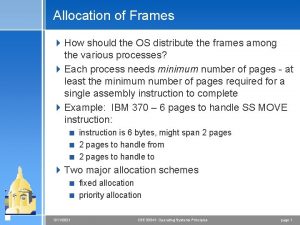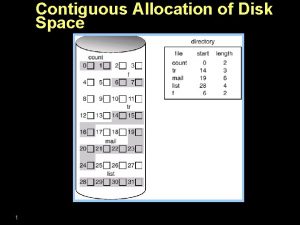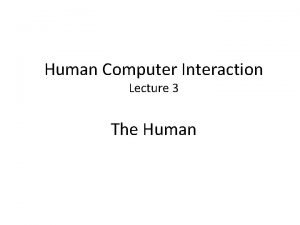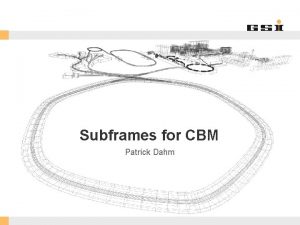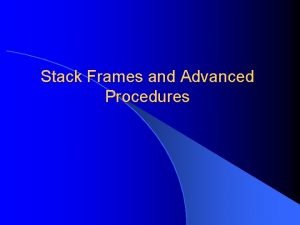Allocation of Frames 4 How should the OS














![Other Issues – Program Structure 4 Program structure < Int[128, 128] data; < Each Other Issues – Program Structure 4 Program structure < Int[128, 128] data; < Each](https://slidetodoc.com/presentation_image_h/35014c26bca3e100b02ad0e8bbad4adf/image-15.jpg)

- Slides: 16

Allocation of Frames 4 How should the OS distribute the frames among the various processes? 4 Each process needs minimum number of pages - at least the minimum number of pages required for a single assembly instruction to complete 4 Example: IBM 370 – 6 pages to handle SS MOVE instruction: < instruction is 6 bytes, might span 2 pages < 2 pages to handle from < 2 pages to handle to 4 Two major allocation schemes < fixed allocation < priority allocation 3/11/2021 CSE 30341: Operating Systems Principles page 1

Fixed Allocation 4 Equal allocation – For example, if there are 100 frames and 5 processes, give each process 20 frames. 4 Proportional allocation – Allocate according to the size of process 3/11/2021 CSE 30341: Operating Systems Principles page 2

Priority Allocation 4 Use a proportional allocation scheme using priorities rather than size 4 If process Pi generates a page fault, < select for replacement one of its frames < select for replacement a frame from a process with lower priority number 3/11/2021 CSE 30341: Operating Systems Principles page 3

Global vs. Local Allocation 4 Global replacement – process selects a replacement frame from the set of all frames; one process can take a frame from another < It is possible for processes to suffer page faults through no fault of theirs < However, improves system throughput 4 Local replacement – each process selects from only its own set of allocated frames < May not use free space in the system 3/11/2021 CSE 30341: Operating Systems Principles page 4

Thrashing 4 If a process does not have “enough” pages, the page-fault rate is very high. This leads to: < low CPU utilization < operating system thinks that it needs to increase the degree of multiprogramming because of low cpu utilization < another process added to the system 4 Thrashing a process is busy swapping pages in and out 3/11/2021 CSE 30341: Operating Systems Principles page 5

Thrashing (Cont. ) 3/11/2021 CSE 30341: Operating Systems Principles page 6

Demand Paging and Thrashing 4 Why does demand paging work? Locality model < Process migrates from one locality to another < Localities may overlap < E. g. for (……) { computations; } for (…. . ) { computations; } 4 Why does thrashing occur? size of locality > total memory size 3/11/2021 CSE 30341: Operating Systems Principles page 7

Working-Set Model 4 working-set window a fixed number of page references Example: 10, 000 instruction 4 WSSi (working set of Process Pi) = total number of pages referenced in the most recent (varies in time) < if too small will not encompass entire locality < if too large will encompass several localities < if = will encompass entire program 4 D = WSSi total demand frames 4 if D > m Thrashing 4 Policy if D > m, then suspend one of the processes 3/11/2021 CSE 30341: Operating Systems Principles page 8

Working-set model 3/11/2021 CSE 30341: Operating Systems Principles page 9

Keeping Track of the Working Set 4 Approximate with interval timer + a reference bit 4 Example: = 10, 000 < Timer interrupts after every 5000 time units < Keep in memory 2 bits for each page < Whenever a timer interrupts copy and sets the values of all reference bits to 0 < If one of the bits in memory = 1 page in working set 4 Why is this not completely accurate? 4 Improvement = 10 bits and interrupt every 1000 time units 3/11/2021 CSE 30341: Operating Systems Principles page 10

Page-Fault Frequency Scheme 4 Establish “acceptable” page-fault rate < If actual rate too low, process loses frame < If actual rate too high, process gains frame 3/11/2021 CSE 30341: Operating Systems Principles page 11

Other Issues -- Prepaging 4 Prepaging < To reduce the large number of page faults that occurs at process startup < Prepage all or some of the pages a process will need, before they are referenced < But if prepaged pages are unused, I/O and memory wasted < Assume s pages are prepaged and α of the pages is used =Is cost of s * α save pages faults > or < than the cost of prepaging s * (1 - α) unnecessary pages? =α near zero prepaging loses 3/11/2021 CSE 30341: Operating Systems Principles page 12

Other Issues – Page Size 4 Page size selection must take into consideration: < fragmentation < table size < I/O overhead < locality 3/11/2021 CSE 30341: Operating Systems Principles page 13

Other Issues – TLB Reach 4 TLB Reach - The amount of memory accessible from the TLB 4 TLB Reach = (TLB Size) X (Page Size) 4 Ideally, the working set of each process is stored in the TLB. Otherwise there is a high degree of page faults. 4 Increase the Page Size. This may lead to an increase in fragmentation as not all applications require a large page size 4 Provide Multiple Page Sizes. This allows applications that require larger page sizes the opportunity to use them without an increase in fragmentation. 3/11/2021 CSE 30341: Operating Systems Principles page 14
![Other Issues Program Structure 4 Program structure Int128 128 data Each Other Issues – Program Structure 4 Program structure < Int[128, 128] data; < Each](https://slidetodoc.com/presentation_image_h/35014c26bca3e100b02ad0e8bbad4adf/image-15.jpg)
Other Issues – Program Structure 4 Program structure < Int[128, 128] data; < Each row is stored in one page < Program 1 for (j = 0; j <128; j++) for (i = 0; i < 128; i++) data[i, j] = 0; 128 x 128 = 16, 384 page faults < Program 2 for (i = 0; i < 128; i++) for (j = 0; j < 128; j++) data[i, j] = 0; 128 page faults 3/11/2021 CSE 30341: Operating Systems Principles page 15

Wrapup 4 Memory hierarchy: < Speed: L 1, L 2, L 3 caches, main memory, disk etc. < Cost: disk, main memory, L 3, L 2, L 1 etc. 4 achieve good speed by moving “interesting” objects to higher cache levels while moving “uninteresting” objects to lower cache levels 4 Hardware provides reference bit, modify bit, page access counters, page table validity bits 4 OS sets them appropriately such that it will be notified via page fault < OS provides policies < Hardware provides mechanisms 4 Implement VM, COW etc. that are tuned to observed workloads 3/11/2021 CSE 30341: Operating Systems Principles page 16
 Allocation of frames
Allocation of frames Allocation of frames in os
Allocation of frames in os Contiguous allocation vs linked allocation
Contiguous allocation vs linked allocation L frames
L frames Titch miller poem
Titch miller poem Say mean matter chart example
Say mean matter chart example Pediatric occupational therapy frames of reference
Pediatric occupational therapy frames of reference An oversized plate merging a drop & through strake.
An oversized plate merging a drop & through strake. Thinking frames
Thinking frames Eccentrically braced frames
Eccentrically braced frames Models of ltm - frames
Models of ltm - frames Counter argument sentence frames
Counter argument sentence frames Frame in linguistics
Frame in linguistics Sue palmer recount skeleton
Sue palmer recount skeleton Truss applied mechanics
Truss applied mechanics Dahm frames
Dahm frames Virtual memory
Virtual memory

